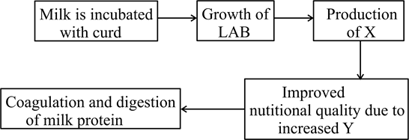Study the following statements regarding Lactic Acid Bacteria (LAB) which are used to convert milk into curd.
(i) They produce acids that coagulate and partially digest the milk proteins.
(ii) A small amount of curd added to the fresh milk as an inoculum contains millions of LAB, which at a suitable temperature, multiply and convert milk into curd.
(iii) Conversion of milk into curd improves its nutritional quality by increasing vitamin B12.
(iv) LAB may result in acidity in the stomach of human beings.
Which of the given statements are correct?
(i) They produce acids that coagulate and partially digest the milk proteins.
(ii) A small amount of curd added to the fresh milk as an inoculum contains millions of LAB, which at a suitable temperature, multiply and convert milk into curd.
(iii) Conversion of milk into curd improves its nutritional quality by increasing vitamin B12.
(iv) LAB may result in acidity in the stomach of human beings.
Which of the given statements are correct?
(i) and (ii)
(ii) and (iii)
(i), (ii) and (iii)
(i), (ii), (iii) and (iv)

Important Questions on Microbes in Human Welfare
Study the following flow chart depicting the formation of curd from milk. Identify the missing parts X and Y.
Read the following statements and select the correct option.
Statement I: Besides curdling milk, LAB also improves its nutritional quality by increasing vitamin .
Statement II: LAB, when present in the human stomach, check disease-causing microbes.
(i) Idli
(ii) Dosa
(iii) Toddy
(iv) Cheese
Match different organisms in Column I with their uses in Column II and select the correct answer from the given codes.
| Column I | Column II | ||
|---|---|---|---|
| Formation of dough | |||
| Single-cell proteins | |||
| Conversion of milk into curd | |||
| Formation of Swiss cheese |
Which of the following option contains the end products formed during anaerobic respiration in yeast?
